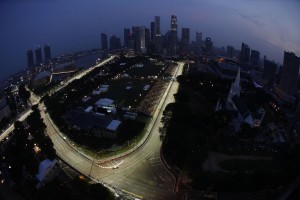Round 13 takes us to yet another street course in this year’s Formula One calendar. The street circuit at Marina Bay

- This is the only race that takes place entirely at night. The track requires of 108,423 meters of power cable and around 1,600 light beams which must be installed through a three month period before the race. Surely you are asking yourself.
- Why at night? The race begins at 8:00 p.m., local time, which ensures the maximum TV exposure and rating in the European market.
- After Monaco, this is the second slowest track of the season, with 23 corners and an average speed of 172 kph. About 46% of the lap is done at full speed, as opposed to 75% in Monza.
- The track with the most corners of the season.
- “The worst curve in Formula One” stated Lewis Hamilton one day, referring to the Singapore Sling curves (10, 10a, 10b) after suffering several incidents in past years. For 2013 this has changed to be one single left hand medium-high speed corner that takes to curves 11 and 12.
- This race first appeared in the Formula One calendar in 2008 despite a controversy that claimed that the drivers were at risk due to the lack of lighting, but after two positive tests it was approved and it has been in the calendar for five years.
- Fernando Alonso and Sebastian Vettel have won twice each. Lewis Hamilton won the other race.
- Fuel load per car is bigger than in any other Grand Prix due to the nature of the track and the duration of the race.
- The race that demands more physically from a driver than all the other Grands Prix. Humidity and heat are so high that a driver can lose up to 3 kilograms in liquids.
¿What does Esteban Gutiérrez thinks of this interesting track??
“The Singapore Grand Prix is a unique event. The atmosphere and excitement is special, because it’s a night race, it’s right in the middle of the city and the crowd is great. Singapore is a tough circuit in terms of how it affects the driver physically. The humidity is very high, so there is less oxygen in the air, and that’s challenging. However, I’m quite used to racing in hot conditions, especially at the beginning of my career competing in Mexico at 45 degrees, but the difference in Singapore is the humidity.
“It impacts on concentration, so that means preparation is very important. There is nothing that you can do or train specifically for that, but I tend to arrive early to get used to the conditions. I like the track, it has a lot of corners and it’s quite long, which makes it fun. My favourite part used to be the Singapore Sling, a left-right-left combination, but that has been changed to a long medium-speed corner for this year.”
Sources:
http://es.wikipedia.org/wiki/Circuito_Urbano_Marina_Bay
http://www.f1latam.com/noticias.php?idn=12206
http://www.bbc.co.uk/sport/0/formula1/24127798
http://www.formula1.com/news/features/2013/9/14984.html








